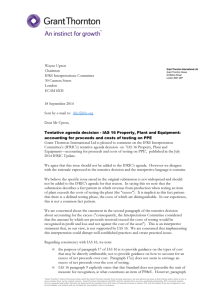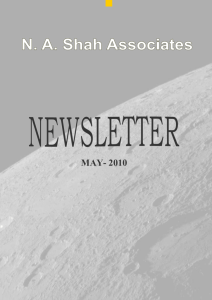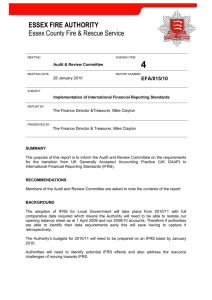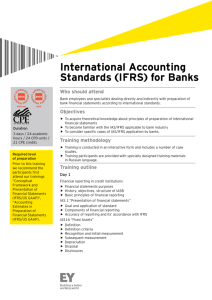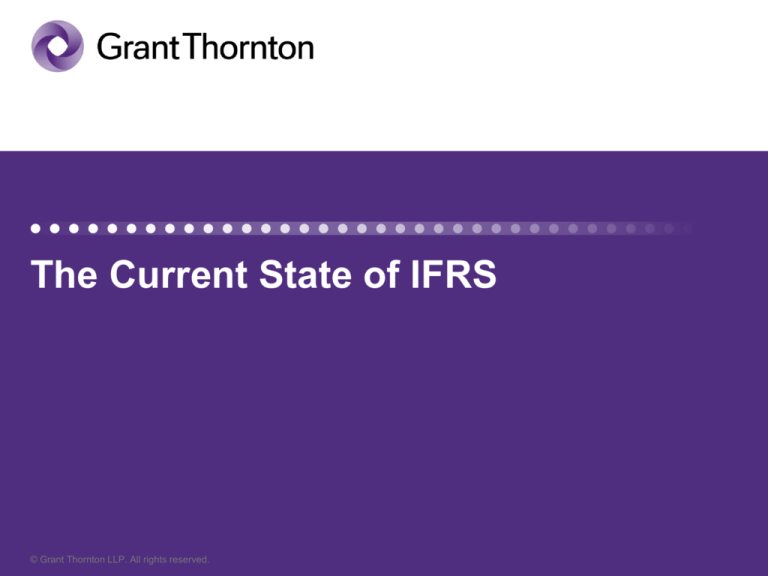
The Current State of IFRS
© Grant Thornton LLP. All rights reserved.
The Current State of IFRS
Objectives & Agenda
Objectives
Agenda
• Recognize what IFRS is
and when it will become
important
• What is IFRS?
• Convergence
• Resources
© Grant Thornton LLP. All rights reserved.
2
What is IFRS?
IASB Structure
Trustee
Appointments
Advisory
Group
advises
IASC
Foundation
appoints
oversees
funds
SAC
advises
IASB
reports
interprets
IFRIC
creates
IFRS
high quality, enforceable and global
© Grant Thornton LLP. All rights reserved.
3
What is IFRS?
IASB Standards and History
1973
↓
2001
2001
↓
Present
International Accounting Standards (IAS)
SIC Interpretations (SIC)
International Financial Reporting Standards (IFRS)
IFRIC Interpretations (IFRIC)
© Grant Thornton LLP. All rights reserved.
4
IASB Standards
RESEARCH
Agenda Decision
PROPOSALS
Input from:
• Advisory Council
• Working Group
• International Groups;
Analysts; Preparers;
Audit technical partners
• Special interest groups
• Local standard-setters
• Regulators
• Political groups
© Grant Thornton LLP. All rights reserved.
Discussion
Paper (DP)
(Optional)
PROPOSALS
Public Consultation
Exposure
Draft (ED)
Published Public Consultation Feedback
Statement
IFRS
Jurisdictional adoption process
IASB two year post-implementation review
5
What is IFRS?
8 IFRSs in effect at 1 January 2008
IFRS 1
First-time Adoption of International Financial Reporting Standards
IFRS 2
Share-based Payment
IFRS 3
Business Combinations
IFRS 4
Insurance Contracts
IFRS 5
Non-current Assets Held for Sale and Discontinued Operations
IFRS 6
Exploration for and Evaluation of Mineral Resources
IFRS 7
Financial Instruments: Disclosures
IFRS 8
Operating Segments
© Grant Thornton LLP. All rights reserved.
6
What is IFRS?
29 IASs in effect at 1 January 2008
IAS 1
Presentation of Financial Statements
IAS 2
Inventories
IAS 7
Statement of Cash Flows
IAS 8
Accounting Policies, Changes in Accounting Estimates & Errors
IAS 10
Events After the Reporting Period
IAS 11
Construction Contracts
IAS 12
Income Taxes
IAS 16
Property, Plant and Equipment
IAS 17
Leases
IAS 18
Revenue
© Grant Thornton LLP. All rights reserved.
7
What is IFRS?
29 IASs in effect at 1 January 2008, continued
IAS 19
Employee Benefits
IAS 20
Accounting for Government Grants and Disclosure of
Government Assistance
IAS 21
The Effects of Changes in Foreign Exchange Rates
IAS 23
Borrowing Costs
IAS 24
Related Party Disclosures
IAS 26
Accounting and Reporting by Retirement Benefit Plans
IAS 27
Consolidated and Separate Financial Statements
IAS 28
Investments in Associates
IAS 29
Financial Reporting in Hyperinflationary Economies
© Grant Thornton LLP. All rights reserved.
8
What is IFRS?
29 IASs in effect at 1 January 2008, continued
IAS 31
Interests in Joint Ventures
IAS 32
Financial Instruments: Presentation
IAS 33
Earnings per Share
IAS 34
Interim Financial Reporting
IAS 36
Impairment of Assets
IAS 37
Provisions, Contingent Liabilities and Contingent Assets
IAS 38
Intangible Assets
IAS 39
Financial Instruments: Recognition and Measurement
IAS 40
Investment Property
IAS 41
Agriculture
© Grant Thornton LLP. All rights reserved.
9
What is IFRS?
24 Interpretations of the IFRIC and its predecessor, the
SIC, in effect at 1 January 2008
SIC 7
Introduction of the Euro
SIC 10
Government Assistance – No Specific Relation to Operating
Activities
SIC 12
Consolidation – Special-Purpose Entities
SIC 13
Jointly Controlled Entities – Non-Monetary Contributions by
Venturers
SIC 15
Operating Leases – Incentives
SIC 21
Income Taxes – Recovery of Revalued Non-Depreciable Assets
SIC 25
Income Taxes – Changes in the Tax Status of an Enterprise or its
Shareholders
SIC 27
Evaluating the Substance of Transactions Involving the Legal
Form of a Lease
© Grant Thornton LLP. All rights reserved.
10
What is IFRS?
24 Interpretations of the IFRIC and its predecessor, the
SIC, in effect at 1 January 2008, continued
SIC 29
Service Concession Arrangements: Disclosures
SIC 31
Revenue – Barter Transactions Involving Advertising Services
SIC 32
Intangible Assets – Web Site Costs
IFRIC 1 Changes in Existing Decommissioning, Restoration and Similar
Liabilities
IFRIC 2 Members’ Shares in Cooperative Entities and Similar
Instruments
IFRIC 4 Determining whether an Arrangement contains a Lease
IFRIC 5 Rights to Interests arising from Decommissioning, Restoration
and Environmental Rehabilitation Funds
IFRIC 6 Liabilities arising from Participating in a Specific Market –
Waste Electrical and Electronic Equipment
© Grant Thornton LLP. All rights reserved.
11
What is IFRS?
24 Interpretations of the IFRIC and its predecessor, the
SIC, in effect at 1 January 2008, continued
IFRIC 7
Applying the Restatement Approach under IAS 29 Financial
Reporting in Hyperinflationary Economies
IFRIC 8
Scope of IFRS 2
IFRIC 9
Reassessment of Embedded Derivatives
IFRIC 10 Interim Financial Reporting and Impairment
IFRIC 11 IFRS 2 – Group and Treasury Share Transactions
IFRIC 12 Service Concession Arrangements
IFRIC 13 Customer Loyalty Programmes
IFRIC 14 IAS 19 – The Limit on a Defined Benefit Asset, Minimum
Funding Requirements, and their Interaction
© Grant Thornton LLP. All rights reserved.
12
What is IFRS?
Current State
Countries that require
or permit IFRSs for
domestic entities
Countries seeking
convergence with, or
pursuing adoption of, IFRSs
© Grant Thornton LLP. All rights reserved.
Source: Deloitte – www.iasplus.com
13
Take 5 minutes
to complete
Activity 1
Principles vs. Rules
Discuss the advantages for a more or less principlesbased standard for each category.
Category
Fewer Rules
(more principles-based)
More Rules
(less principles-based)
Clients
Regulators
Litigation
Skill Set
Work Satisfaction
© Grant Thornton LLP. All rights reserved.
14
Group check
IFRS are pure principles-based standards
True
False
© Grant Thornton LLP. All rights reserved.
15
Group check
Debrief
IFRS are pure principles-based standards
True
False
© Grant Thornton LLP. All rights reserved.
16
Group check
U.S. GAAP are not based on sound, accepted accounting
principles
True
False
© Grant Thornton LLP. All rights reserved.
17
Group check
Debrief
U.S. GAAP are not based on sound, accepted accounting
principles
True
False
© Grant Thornton LLP. All rights reserved.
18
What is IFRS?
Principles vs. Rules
Principles
Only
© Grant Thornton LLP. All rights reserved.
U.S.
IFRS GAAP
Rules
Only
19
Financial Statement Comprise:
IFRS
•
•
•
•
•
Balance sheet
Income statement
A statement showing either:
– All changes in equity; or
– Changes in equity other than
those arising from capital
transactions with owners and
distributions to owners (called a
Statement of Recognised Income
and Expense (SORIE))
Cash flow statement (no exemptions)
Accounting policies and explanatory
notes (IAS 1.8)
GAAP
•
•
•
•
•
•
•
© Grant Thornton LLP. All rights reserved.
Balance sheet
Income statement
Statement of comprehensive income.
This statement may be combined
with the income statement or the
statement of changes in
stockholders’ equity (SFAS130.22)
Statement of changes in
stockholders’ equity.
Alternatively, disclosure of changes
in the separate accounts comprising
stockholders' equity (in addition to
retained earnings) could be made in
the notes to financial statements
(APB 12.10)
Statement of cash flows (limited
exemptions; see Section 2.5)
Notes to financial statements
20
Comparison of IFRS and US GAAP
IFRS
GAAP
A finance lease is not determined by a bright lines
test. Instead, IAS 17 lists factors normally
indicating a finance lease, including any of the
following (IAS 17.10):
A capital lease is one that meets one or more of the
following criteria (SFAS 13.7):
•
•
•
•
•
•
•
Transfer of ownership by end of lease term
Lessee has option to purchase asset on such
favourable terms such that option exercise is
reasonably certain at inception
Lease is for major part of asset's life, even if no
purchase option exists
Present value of minimum lease payments at
inception amounts to at least substantially all of
the fair value of the leased asset
Leased assets are specialised such that only
the lessee can use them without major
modification
•
•
Lease transfers ownership of the property to the
lessee by the end of the lease term
Lease contains a bargain purchase option
Lease term is equal to 75 percent or more of the
estimated economic life of the leased property.*
Present value at the beginning of the lease term
of the minimum lease payments, excluding that
portion of the payments representing executory
costs to be paid by the lessor, including any
profit thereon, equals or exceeds 90 percent of
the excess of the fair value of the leased
property to the lessor at the inception of the
lease over any related investment tax credit
retained by the lessor and expected to be
realized by the lessor.*
For the lessor to classify a lease as a capital lease,
the following additional criteria must also be met
(SFAS 13.8):
© Grant Thornton LLP. All rights reserved.
21
What is IFRS?
Principles vs. Rules
• Industry accounting not adequately addressed
– Insurance contracts
– Extractive activities
• No IFRS equivalent
– In absence of a standard that specifically applies,
• Management should use judgment
• Should not conflict with IFRS
• May also consider other GAAP
© Grant Thornton LLP. All rights reserved.
22
The Current State of IFRS
Objectives & Agenda
Objectives
Agenda
• Recognize what IFRS is
and when it will become
important
• Communicate key points
about IFRS to your clients
• What is IFRS?
• Convergence
• Resources
© Grant Thornton LLP. All rights reserved.
23
Convergence
Definition
Where transactions or events are the same or similar, the
accounting should be the same, or there should be enough
transparency in the disclosures to allow the reader to
understand the differences.
(Plus a continuing effort by standard setters to
reduce differences between systems over time.)
© Grant Thornton LLP. All rights reserved.
24
Convergence
Movement toward one set of standards - benefits
Investor confidence and understanding
Lower risk premium
Lower cost of capital
© Grant Thornton LLP. All rights reserved.
25
Convergence
Movement toward one set of standards - benefits
Greater transparency
Greater credibility
Greater comparability between companies wherever they are
Greater cross-border capital flows
Most efficient allocation of capital
Thriving economies
© Grant Thornton LLP. All rights reserved.
26
Convergence
Movement toward one set of standards - obstacles
•
•
•
•
•
National pride
Endorsement process
Legal issues
Standard setters
Language
© Grant Thornton LLP. All rights reserved.
27
Group check
Which of the following is most correct?
1. U.S. GAAP and IFRS are already converged
2. U.S. GAAP and IFRS are not converged but will be
eventually
3. U.S. GAAP and IFRS will never be converged
4. U.S. GAAP and IFRS are sufficiently converged
to be acceptable in the U.S. capital markets
© Grant Thornton LLP. All rights reserved.
28
Group check
Debrief
Which of the following is most correct?
1. U.S. GAAP and IFRS are already converged
2. U.S. GAAP and IFRS are not converged but will be
eventually
3. U.S. GAAP and IFRS will never be converged
4. U.S. GAAP and IFRS are sufficiently converged
to be acceptable in the U.S. capital markets
© Grant Thornton LLP. All rights reserved.
29
Convergence
U.S. Convergence – FASB/IASB
• 2002 Norwalk Agreement
• 2006 Memorandum of Understanding (MOU)
• 2008 Memorandum of Understanding (MOU)
© Grant Thornton LLP. All rights reserved.
30
Convergence
U.S. Convergence – FASB/IASB
• FASB adopts IASB standard
– Fair value option (SFAS 159)
– Research and development assets acquired in a
business combination (SFAS 141 – revised 2007)
• IASB adopts FASB standard
– Borrowing costs (IAS 23 – revised 2007)
– Segment disclosures (IFRS 8)
© Grant Thornton LLP. All rights reserved.
31
Convergence
U.S. Convergence - FASB/IASB
Short–term convergence
To be examined by the FASB
To be examined by the IASB
Income taxes (joint project)
Income taxes (joint project)
Investment properties
Joint arrangements (joint
ventures)
Research and development
Subsequent events
Short-term projects deferred
• Government grants
• Impairment
© Grant Thornton LLP. All rights reserved.
32
Convergence
U.S. Convergence – FASB/IASB
Major joint projects
•
•
•
•
•
•
•
•
•
Consolidations
Derecognition
Fair value measurement
Financial instruments
Financial statement presentation
Leases
Liabilities and equity distinctions
Post-employment benefits (including pensions)
Revenue recognition
© Grant Thornton LLP. All rights reserved.
33
Convergence
U.S. Convergence – FASB/IASB
Conceptual Framework – joint project
• Mentioned in the 2008 MOU; however no specific timetable
• Major joint projects will take account of ongoing Conceptual
Framework projects
© Grant Thornton LLP. All rights reserved.
34
Convergence
U.S. Convergence - SEC
Roadmap – 7 milestones
1. Improvements in accounting standards
2. Funding and accountability of IASCF
3. Improved ability to use XBRL for IFRS
4. Education and training on IFRS in the U.S.
5. Limited early use by select few
6. Anticipated future rulemaking
7. Potential implementation sequence – FYE on or after 15 December
− Large Accelerated Filers 2014
− Accelerated Filers 2015
− Non-Accelerated Filers 2016
© Grant Thornton LLP. All rights reserved.
35
What’s your opinion?
Within the next few years the FASB will be irrelevant and
should disband
True
False
© Grant Thornton LLP. All rights reserved.
36
Convergence
U.S. Convergence - SEC
• Policy issues
• International Organization of Securities Commissions (IOSCO)
2000
Concept
Release
April
2005
Roadmap
August
2007 December
March 2007
Proposing 2007
Roundtables
Release Final Rule
July 2007
Proposing
Release
© Grant Thornton LLP. All rights reserved.
December
2007
Roundtables
37
Convergence
Rest of the world
Country
Status
Europe
Required (as adopted by EU)
Argentina
Required starting 2011 (awaiting approval)
Australia and National standards described as IFRS equivalent
New Zealand Include unreserved statement of compliance
Brazil
Required starting 2010; optional before
Canada
Required starting 2011
Chile
Required starting 2009
China
Must use Accounting Standards for Business Enterprises, which
are close but not exactly IFRS. Companies listed in Hong Kong
have choice of IFRS or HK FRS
India
Required starting 2011
© Grant Thornton LLP. All rights reserved.
38
Convergence
Rest of the world, continued
Country
Status
Japan
Japanese GAAP to converge to IFRS by 2011
South Korea
Required starting 2011; permitted 2009
Mexico
Permitted
Peru
Required
Russia
Required for banks
Singapore
Singapore IFRS – changed several IFRSs and did not adopt others
South Africa
Required
Switzerland
Permitted
Turkey
Permitted
Uruguay
Must use IFRS in existence at 19 May 2004
USA
Not permitted; concept release out for comment
© Grant Thornton LLP. All rights reserved.
39
Convergence
Application
• Jurisdictional variations
• Different interpretations
• Small and Medium-sized Entities (SMEs)
© Grant Thornton LLP. All rights reserved.
40
What’s your opinion?
Choose either View A or View B
View A
The SEC should allow
market forces to
determine when to
allow IFRS in the U.S.
© Grant Thornton LLP. All rights reserved.
View B
The SEC should decide
what is best for the U.S.
markets and mandate
IFRS when it is ready
41
Activity 2
Take 2 minutes
to complete
Are companies ready for IFRS?
Discuss the characteristics of a company that is unprepared to
adopt IFRS and one that is prepared.
Unprepared Company
© Grant Thornton LLP. All rights reserved.
Prepared Company
42
Activity 2
Debrief
Unprepared Client
Prepared Client
• Waits until the switch to IFRS is
• Budgets for a project to evaluate
mandatory
what will change if it switches to
IFRS
• Has the accounting staff prepare
excel spreadsheets to support
• Project team includes accounting,
top-level adjustments to its U.S.
reporting, operations and IT
GAAP statements
• Produces pro forma statements
• Misses some items that are
two years prior to changeover
caught at the last minute by the
– Highlights how reported results
GT audit team
will change
• Disclosures are so poorly written it
– Allows better evaluation of
gets several comment letters from
transition options
the SEC on its late filing
– Highlights needed changes in
information requirements & IT
© Grant Thornton LLP. All rights reserved.
43
Next Steps
What you need to know
•
•
•
•
•
Whether and when to switch to IFRS
Required
Competition
Cost / benefit
Future developments
© Grant Thornton LLP. All rights reserved.
44
How will movement to IFRS impact Financial Reporting?
Concerns:
•
•
•
•
•
Data collection
Potential impact on tax liability
Potential increased volatility in reporting
Potential change in patter of earnings
Potential increased financial disclosures
© Grant Thornton LLP. All rights reserved.
45
How will movement to IFRS impact Financial Reporting?
Benefits:
•
•
•
•
Potential cost savings
Opportunity to review and improve process
Potential impact on tax liability
Increased access to funds and markets
© Grant Thornton LLP. All rights reserved.
46
Top Twenty Issues to Consider
1 IAS 1 Presentation issues: judgments and estimates
2 IAS 1 Presentation issues: primary statement formats
3 IAS 36 Impairment disclosures
4 IFRS 3 Goodwill justification disclosure
5 IFRS 3 Other business combination issues and disclosures
6 IFRS 7 Financial instruments: disclosures
7 IAS 12 Deferred tax accounting and disclosure
8 Accounting policies general messages
9 Accounting policies specific problems: revenue
10 Accounting policies specific problems: financial instruments
11 IFRS 1 Explanation of transition to IFRS
12 IFRS 5 Non-current assets held for sale and discontinued operations
13 IAS 14 Segment information
14 IAS 37 Provisions disclosure
15 IAS 39 Financial instruments: recognition and measurement
16 Standards in issue not yet effective
17 Operating items and exceptional items
18 Comparative information
19 IAS 19 Employee Benefit Disclosures
20
Detail
forget
© Grant
Thornton counts
LLP. All rightsdon't
reserved.
47
The Current State of IFRS
Objectives
Agenda
• Recognize what IFRS is
and when it will become
important
• Communicate key points
about IFRS to your clients
• What is IFRS?
• Convergence
• Resources
© Grant Thornton LLP. All rights reserved.
48
Grant Thornton Resources
• IFRS Resource Center
http://www.grantthornton.com/portal/site/gtcom/menuitem.9
1c078ed5c0ef4ca80cd8710033841ca/index561b974be3
0c92e309882716712c24c3.html?vgnextoid=bb444cfadd
5d3110VgnVCM1000003a8314acRCRD
© Grant Thornton LLP. All rights reserved.
49
For additional information, visit these Web sites:
AICPA
•
•
International Financial Reporting Standards (IFRS) – An AICPA Backgrounder at
www.ifrs.com
For the latest information on the status of IFRS and educational opportunities
visit www.ifrs.com
IASB
• Memorandum of Understanding with the FASB:
http://www.iasb.org/Current+Projects/Memorandum+of+Understanding+with+th
e+FASB.htm
•
IFRS summaries:
http://www.iasb.org/IFRS+Summaries/IFRS+and+IAS+Summaries+English+200
8/IFRS+and+IAS+Summaries+English.htm
FASB
•
Overview of International Activities: http://www.fasb.org/intl/
SEC
•
International Financial Reporting Standards Road Map:
http://www.sec.gov/spotlight/ifrsroadmap.htm
© Grant
Thornton LLP. All rights reserved.
50


